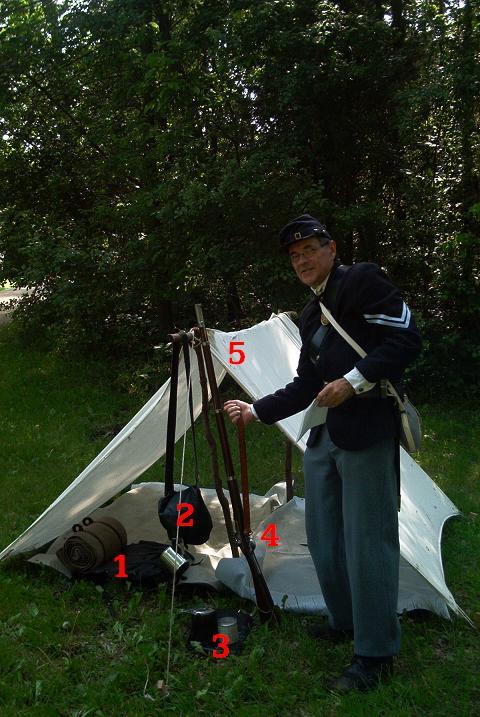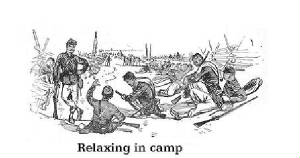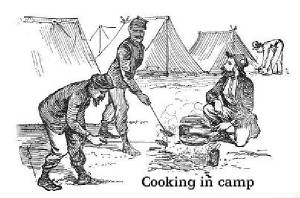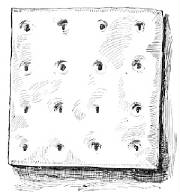 Now, here we have a picture of Corporal Dills at his tent. If you had been in the 5th Minnesota during the Civil War, you
might have lived in a tent just like this. Let's take a look at what Corporal Dills has here. 1. This is the Corporals KNAPSACK
(a military backpack where soldiers kept their spare clothing and personal stuff) and BED-ROLL (a bed-roll is usually a blanket
or two rolled up for easy carrying). The Corporal will remove his bed-roll and lay it out in the tent when he is ready to
sleep. 2. This is the Corporals HAVERSACK. A haversack is where a Civil War soldier would keep their food, and MESS KIT (a
mess kit is what a soldier eats with-knife, fork, spoon, and plate or bowl). You can see that the Corporal has attached his
TIN CUP (used for drinking) to his haversack. 3. Here we see a couple of items together, the Corporals MUCKET, and a TIN OF
CONDENSED COFFEE. A Mucket is like a large tin cup with a lid and handle, used for cooking-like a small cooking pot. Because
infantry soldiers like Corporal Dills walk almost everywhere they go, they cannot carry large heavy cook pots. A Mucket like
this does a fine job in camp over a fire. Now, whatever is a Tin of Condensed Coffee? Civil War soldiers drank A LOT OF COFFEE
(we'll go more into this later on), and condensed coffee is an early version of instant coffee-much like people drink in 2006!
4. This is the Corporal's GUM BLANKET. What? A blanket made of chewing gum? No, not quite. "Gum" during the Civil
War means "Rubber"-so this canvas blanket is painted with rubber on one side. It is used to help keep dirt and moisture(water)
from soaking into a soldier's bed-roll and clothes. 5. Lastly is the tent itself. This tent is known as a SHELTER HALF. If
you look close, you can see buttons. Each soldier would carry half of a tent, and button their half to their friend's (called
a PARD)to make a whole tent. Just looking at this tent, you can probably tell that they weren't very good for keeping out
weather or bugs. Soldier's called the shelter half a DOG TENT, because they were just big enough to suit a dog. Soldier's
wouldnt always sleep in a dog tent though. Sometimes, when a company (or about 100 men) marched as a regiment (1000 men, or
10 company's) they would have wagons to carry bigger, more comfortable tents. When this happend, a soldier might have ended
up sleeping in tents like these below-an A FRAME or SIBLEY TENT.
 Well, now we know where you would live, but what would you do when in camp? Well, when in an Army there is always work to
do. Gathering firewood, fetching water, digging sinks (a sink is a Civil War name for bathroom-like an outhouse)-these are
called FATIGUE DUTIES. Soldiers would also spend up to 6 hours each day in DRILL. Drill is when someone practices marching
and other soldiering. But when soldiers weren't doing these things, they would relax. But what did soldiers do for fun?
 When soldiers had time to relax, one of the first things they did was write letters home. A lot of people don't realize it,
but most people who served in the Union Army could read and write pretty well. Soldiers lonely for home would write letters,
or even send some of their pay to their families. Other soldiers would read newspapers, dime novels (which were cheap short
books available from Sutlers. A Sutler is usually a civilian that sells things to soldiers), or read letters from home aloud
to their pards. Soldiers played games like cards, checkers(called Droughts), and gambled with dice games like chuck-a-luck.
You might have a foot race, or wrestle. Sometimes soldiers were lucky enough to be near a REFRESHMENT SALOON, or a place that
is set up for soldiers to relax. The most famous of these was in Philadelphia, and offered soldiers food, drink, and friendly
company-all for free. If you were a soldier in the 5th Minnesota, you would probably also use time in camp to mend torn clothing
or even just catch up on sleep.

"An Army moves on its' Stomach", is an old expression that suggest that no army can move without being fed. This
is of course, quite true. So, that being said, what sorts of things might you eat if you were a soldier in the 5th Minnesota?
Here is a list of what you might eat as a soldier. It is very important to remember that food delivered to soldiers was rarely
very fresh. Most would have been dried, salted, or pickled to keep it from rotting. Even so, it wasn't uncommon for a Civil
War Soldier to end up with spoiled food. Don't forget, we don't have refrigerators yet!
1. Coffee. A LOT of coffee.
2. Beans
3. Bacon (both the good kind you get in the grocery store today, as well as the not-so-good kind known as "Sow Belly"
which is almost nothing but fat)
4. Bread (both soft AND hard. Hard bread was called HARDTACK in the east, and looked a lot like a giant saltine cracker.
Hard bread was sometimes so hard it needed to be soaked in coffee to even eat it!)
5. Dried and fresh vegetables or fruit (like potatoes, onions, raisins, apples)
6. Oatmeal (not the nice flavored instant kind!)
7. Salt Beef (Sometimes not very fresh at all, and then called "Salt Horse"-which smelled bad and tasted worse!)
8. Rice
9. Salt & Sugar
10. Pickled Cabbage
11. Pickles
12. Dried (called desicated) Peas
13. Molasses
14. Corn Meal
17. Vinegar
This was the OFFICIAL ration listed by the Army, but remember that not all regiments were given all of this at one time.
Some got all of it, some got more of one than others. Soldiers would often supplement their rations with items they bought,
or "SCROUNGED". Scrounging (also called FORAGING) is when a soldier goes out and tries to find food on his own.
This sometimes meant wild fruits and berries, maybe wild game. But MOSTLY this one done in two ways; Buying the goods, or
stealing them. Soldiers had lots of opportunities to buy pies, and other foods from civilians and civilian sutlers along the
march or when camped near a town. Sometimes though, soldiers would raid farmers fields or barns and take food without permission.
This is discouraged in the Union Army, but the practice of "Requesition" (or he Army term for taking something with
or wthout permission) went on anyway.
Soldiers would get very good at finding new ways to cook things using what they had available to them. Want to know what
it is like to eat like a soldier in the 5th Minnesota? With the help of an adult, you can make your very own Hard bread (Hardtack)
to try yourself. Here is a recipe for Civil War Hard Bread (Hardtack):

2 cups of flour
1/2 to 3/4 cup water
1 tablespoon of Crisco or vegetable fat
6 pinches of salt
Mix the ingredients together into a stiff batter, knead several times, and spread the dough out flat to a thickness of
1/2 inch on a non-greased cookie sheet. Bake for one-half an hour at 400 degrees. Remove from oven, cut dough into 3-inch
squares, and punch four rows of holes, four holes per row into the dough. Turn dough over, return to the oven and bake another
one-half hour. Turn oven off and leave the door closed. Leave the hard bread in the oven until cool. Remove and enjoy!
You may find that you like Hard bread when you make it yourself. It will be warm and soft still, and Civil War soldiers
would have liked it that way too! The problem is, when the average soldier received his hard bread, it may well have been
sitting in a box already for 2 years!
|
 |
|